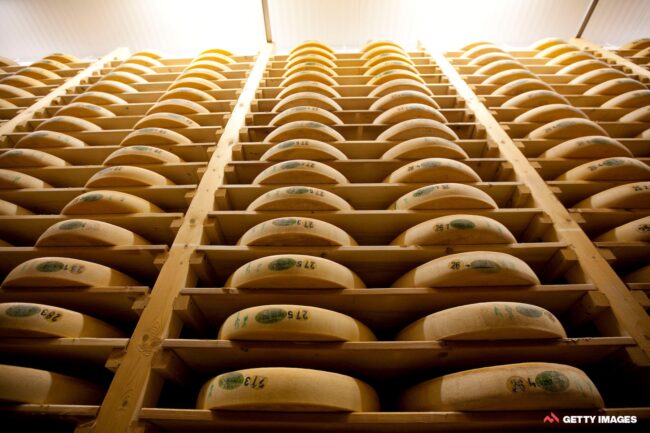||

Hors Course stage 8: In the country of the versatile Comté cheese
As heard on the Tour Daily podcast, José Been is taking us off the race route for some local historical and cultural context for each stage, from Denmark all the way to Paris.
You were worried, weren’t you? We are seven stages into the Tour de France and I haven’t mentioned any cheese yet. This is out of character, I know. But today we are in the Franche-Comté region, on the border with Switzerland. It’s the home of one the best cheeses of the country. I am talking about the versatile Comté: melt it, throw it in a salad, make a sandwich with it or just eat it with some grapes and walnuts on a platter.
The mountain range that is home to Comté cheese is the Jura. Since 1958, this cheese has had the AOP quality mark, indicating the brand is protected and not every cheese that is similar in taste and look can call itself Comté. Before a cheese is AOP it has to follow some rules.
The milk from which the cheese is made must come from a specific breed of cows: the so-called Montbéliarde cow. The milk from these cows must be processed within 24 hours without dyes or preservatives. The cows must have enough space. In summer they graze high in the mountains and mainly eat herbs and various grasses. You can taste this in the characteristic taste and aroma of Comté: fresh and nutty, as well as spicy and fruity.
Comté is produced in small cheese dairies in mountain chalets in the Jura. These are the so-called fruitières, joint workshops whose history dates back to the 13th century. The large round cheeses that can weigh 40-80 kilos have been produced in the same way for centuries. At least 500 litres of milk are needed per cheese, which required cooperation between the farmers because one farmer could never supply so much milk in one day.
Comté is made from raw milk. The milk is heated to about 56 degrees Celsius (in contrast to most raw milk cheeses, where this is 34 degrees). This temperature ensures that the cheese has a firmer structure. The cheese is removed from the mold after just a few hours and remains in the cheese factory for a week to dry. After this, it goes to a so-called maturation cellar for 4 to 24 months. During this period, the cheeses are regularly salted and turned. After ripening, the appearance and taste are checked before the cheese is given the green ‘Comté’ label. The aging process and the milk give the Comté its delicious full, creamy and slightly spicy character.
For me the perfect Comté is a relatively young one: around six to nine months. You can buy it in every supermarket. If you don’t buy the bottom shelf version, major supermarkets have Comté of relatively good quality.
Another splendid cheese from this region is the Morbier with its characteristic layer of grey black ash in the middle.
Morbier was created because the cows did not give enough milk for the Comté in the winter months. Morbier then was made from the milk that the cows gave in the morning. This was pressed into the mould, but there wasn’t enough for the whole mould. To prevent vermin, the cheese was sprinkled with ashes. In the evening the cows were milked again. Cheese was also made from this. This cheese was placed on top of the ash layer and until the cheese moulds were full. Contrary to what you might think, the ash layer does not add much flavor to the cheese.
Speaking of cheese, today’s stage starts in Dole which is the birthplace of Louis Pasteur, inventor of pasteurization. He was born in Dole in 1822. Pasteurization is the process in the food industry that destroys harmful bacteria in perishable food products by briefly heating the food, without changing the taste of the product too much.
||-------------------------------------
By: José Been
Title: Hors Course stage 8: In the country of the versatile Comté cheese
Sourced From: cyclingtips.com/2022/07/hors-course-stage-8-in-the-country-of-the-versatile-comte-cheese/
Published Date: Sat, 09 Jul 2022 11:33:31 +0000
Did you miss our previous article...
https://playeverysport.com/recreational-sports/mossberg-940-pro-tactical-review-a-personaldefense-firearm-thats-a-capable-competition-shotgun
.png)





